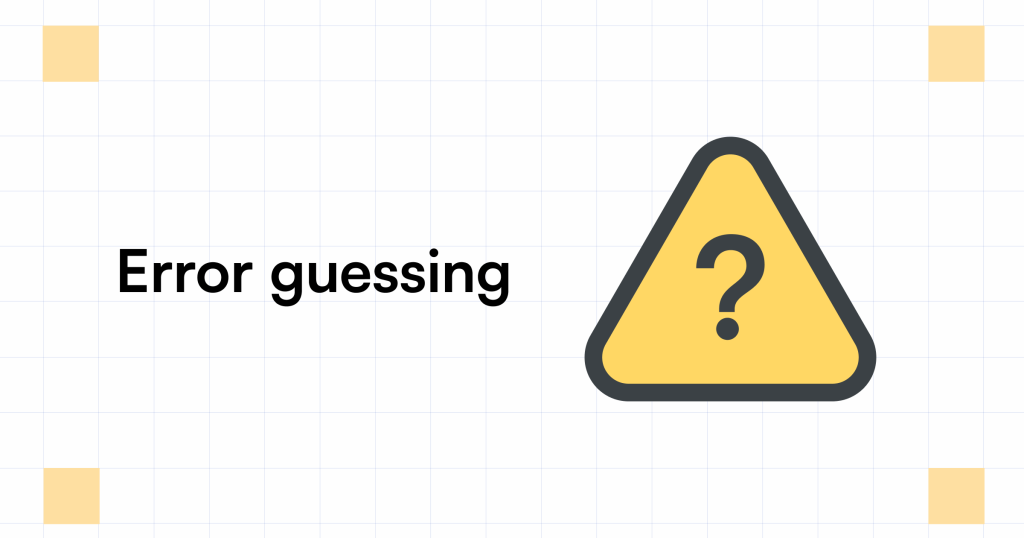
Hi All,
Today, we would understand about the error guessing in software testing.
What Is Exploratory Testing?
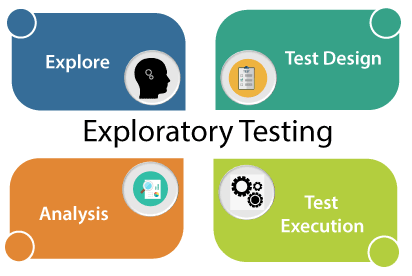
Exploratory Testing is an unscripted, manual software testing approach where testers evaluate the system without predefined test cases or prior exposure to the system. Instead of adhering to a rigid test plan, testers delve directly into testing, spontaneously deciding what aspects to assess on the spot.
Before the testing phase, testers might outline certain concepts or areas to explore, but the core of exploratory testing lies in the tester’s personal freedom and responsibility in simultaneous knowledge acquisition and quality assessments. In essence, exploratory testing resembles an adventurous journey where testers confront the unknown, employing specific techniques to unravel mysteries.
During exploratory testing, testers engage with the software by actively interacting with its features, observing its behavior, and experimenting with different functionalities. They may deliberately challenge the software by inputting unexpected data, exploring edge cases, or intentionally attempting to break the system to uncover potential issues. The key objective is for testers to comprehend the system’s workings and propose systematic testing strategies, thereby fulfilling their task.
Why Exploratory Testing?
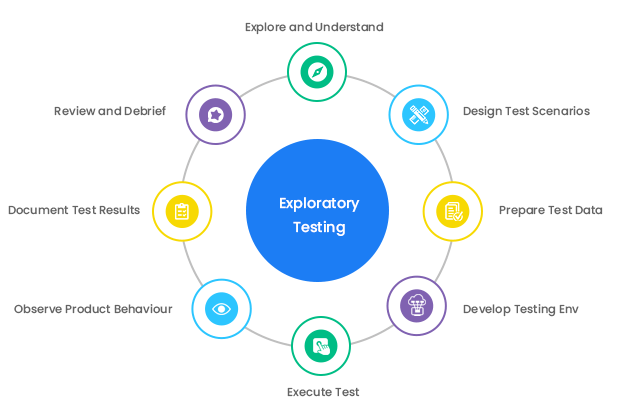
Exploratory testing is an approach to software testing where testers simultaneously design and execute test cases based on their exploration of the software application. Unlike traditional scripted testing, there are no predefined test cases in exploratory testing. Testers rely on their domain knowledge, intuition, and creativity to explore the software, interact with its features, and identify defects and issues. The primary goal of exploratory testing is to uncover unexpected behaviors, assess the software’s usability, and provide rapid feedback to developers. Testers make spontaneous decisions about what to test, how to test, and what areas of the application require deeper scrutiny, allowing for a more flexible and adaptive testing process.
Exploratory testing is a valuable tool for software testing because it offers a number of advantages over traditional scripted testing.
Flexibility and adaptability
Exploratory testing is a very flexible and adaptable testing approach. It can be used to test any type of software, from simple websites to complex enterprise applications. It is also well-suited for testing in Agile development environments, where the software is constantly changing.
Bug discovery
Exploratory testing is very effective at finding bugs, especially complex and unexpected bugs. This is because testers are free to explore the software in any way they see fit, without being limited by a pre-defined set of test cases.
Learning and improvement
Exploratory testing helps testers to learn about the software and to identify areas that need improvement. This is because testers are constantly exploring and experimenting with the software.
Cost reduction
Exploratory testing can help to reduce the cost of testing by eliminating the need to create and maintain a large set of test cases.
Efficiency
Exploratory testing can be more efficient in certain situations, especially when detailed documentation of test cases is not feasible or when the application is constantly evolving. Testers can focus on critical areas and use their time effectively.
Complementing Automated Testing
While automated testing is valuable for repetitive and regression testing, exploratory testing complements it by providing a human perspective and creativity that automated tests lack. It helps in finding issues that automation scripts might not have been designed to detect.
Exploratory Testing Example
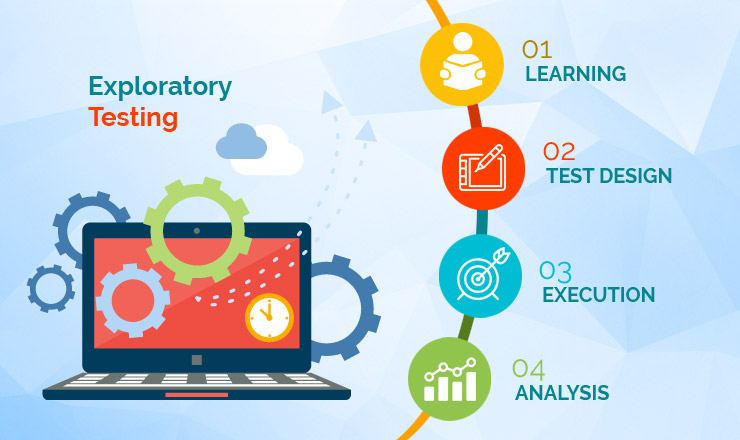
Imagine you are a tester assigned to perform exploratory testing on an e-commerce website’s checkout process. The goal is to ensure a smooth and error-free experience for users making purchases. Here’s how exploratory testing might unfold in this scenario:
Charter:
The goal of the exploratory testing session is to find bugs in the login process of the new social media website.
Exploration:
The tester starts by trying to create a new account on the website. They try different usernames and passwords, and they also try to create an account using an invalid email address. Once they have created an account, the tester tries to log in using different usernames and passwords, including valid and invalid ones. They also try to log in using different devices and browsers.
Learning:
The tester learns from their exploration that the login process is working as expected for most cases. However, they do find a bug where the website crashes if the user enters an invalid username more than three times.
Execution:
The tester designs a test case to reproduce the bug. They then execute the test case and confirm that the bug still occurs.
Evaluation:
The tester documents the bug and reports it to the development team.
This is just a simple example of how exploratory testing can be used to test a software application. Exploratory testing can be used to test any aspect of a software application, from the user interface to the backend logic.
Ad Hoc Testing
Conduct ad hoc tests by entering unexpected inputs during the checkout process. Try entering symbols or special characters in the address fields. Attempt to add more items to the cart than the available stock. See how the system responds to such unexpected inputs.
Browser and Device Compatibility
Test the checkout process on various web browsers (Chrome, Firefox, Safari, etc.) and devices (desktop, tablet, mobile). Ensure that the layout remains consistent, and all functionality works as expected across different platforms.
Input Validation Errors
Identifying input validation issues is a crucial aspect of error guessing. Testers use this technique to uncover problems related to inputs, including unusual characters, lengthy inputs, or unexpected combinations of values. The purpose is to assess how the system responds to these inputs, checking for graceful handling or unexpected behavior and vulnerabilities.
Error guessing enables testers to engage in creative thinking and anticipate likely faults by exploring different aspects of the software system. It encourages testers to adopt a user’s perspective, searching for scenarios that could reveal issues. This approach helps testers identify vulnerabilities, enhance software stability, and deliver an improved user experience. Error guessing serves as a supplement rather than a replacement for formal testing, adding valuable human insight and creativity to the testing process. Leveraging intuition and investigative skills, error guessing becomes a valuable addition to the software testing toolkit.
Pros and Cons To Exploratory Testing?
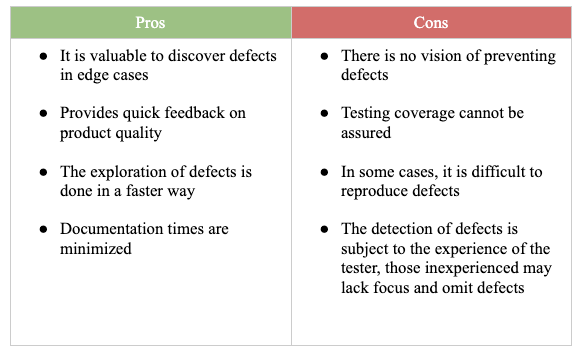
Pros of Exploratory Testing:
- Flexibility: Exploratory testing adapts well to changing project requirements and dynamic development environments, making it ideal for agile methodologies where flexibility is key.
- Creativity and Intuition: Testers can use their creativity, intuition, and domain knowledge to explore the software application from a user’s perspective, uncovering issues that scripted tests might overlook.
- Real User Experience: By simulating real user interactions, exploratory testing provides valuable insights into the user experience, ensuring that the software is user-friendly and intuitive.
- Efficiency: Exploratory testing can be more efficient in certain situations, allowing testers to focus on specific areas without the constraints of pre-defined test cases. This efficiency is particularly useful for rapid feedback in fast-paced development cycles.
- Early Issue Detection: Testers can quickly identify critical issues, enabling early detection and resolution. This rapid feedback loop is invaluable for addressing problems in the early stages of development.
Cons of Exploratory Testing:
- Lack of Documentation: Exploratory testing often lacks detailed documentation, making it challenging to reproduce specific scenarios, track progress, or validate results comprehensively.
- Dependency on Tester’s Skills: The effectiveness of exploratory testing relies heavily on the tester’s skills and experience. Inexperienced testers may miss important scenarios or issues, leading to incomplete testing coverage.
- Limited Repeatability: Exploratory testing might not be suitable for repetitive tests where the same set of test cases needs to be executed multiple times, as it lacks the repeatability of scripted testing.
- Challenge in Measurement: It can be difficult to measure the progress and coverage of exploratory testing accurately, making it challenging to assess the thoroughness of the testing process.
- Potential Bias: Testers might unintentionally focus on specific areas of the application based on their biases or assumptions, potentially overlooking critical issues in other parts of the software.
Here are some tips for using exploratory testing effectively:
- Use a charter: Create a charter for each exploratory testing session to define the scope and goals of the session.
- Use risk-based testing: Focus your exploratory testing on the areas of the software that are most likely to contain bugs.
- Use a variety of testing techniques: Use a variety of testing techniques, such as black-box testing, white-box testing, and gray-box testing, to find the widest range of bugs.
- Document your findings: Document your findings in detail so that you can reproduce them and share them with other testers.
When to use the Exploratory technique in software testing?
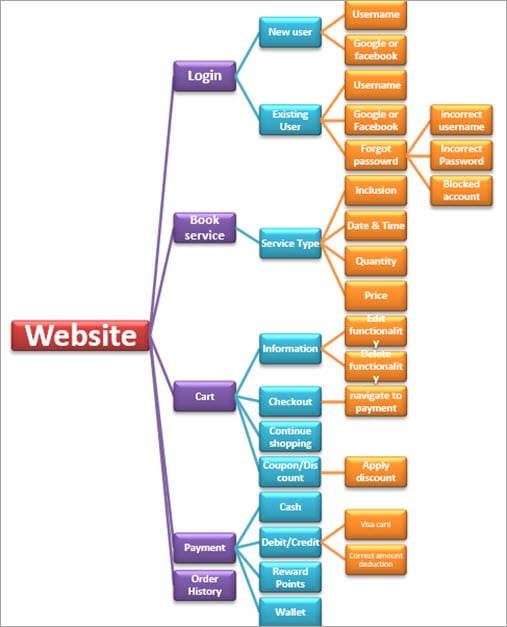
The exploratory testing technique is a valuable approach in software testing and proves particularly useful in various scenarios:
- Early Development Stages: Exploratory testing can initiate during the early phases of software development when formal test cases might still be evolving. Testers can begin exploring the software, identifying issues, and offering prompt feedback.
- Complex or Agile Environments: In complex software projects or agile development environments where software changes rapidly, exploratory testing provides flexibility. Testers can adapt swiftly to changes and explore the software without rigidly predefined test cases.
- Usability and User Experience Testing: Exploratory testing is effective for evaluating the user interface, usability, and overall user experience. Testers can replicate genuine user interactions, pinpointing issues that influence how users perceive and engage with the software.
- Ad-Hoc Testing: When time constraints limit the creation of formal test cases, exploratory testing enables testers to initiate testing without a predetermined script. This is especially useful when time is a critical factor.
- Security Testing: Exploratory testing is invaluable for security assessments, allowing testers to simulate potential attacker behaviors. This unstructured approach helps identify vulnerabilities and security weaknesses.
- Regression Testing: Exploratory testing complements scripted regression testing by enabling testers to explore areas of the software prone to regressions or interactions with recent code changes.
- Bugs and Issue Discovery: It is an effective method for discovering unexpected defects and issues. Testers employ creativity and intuition to simulate scenarios that could lead to problems, ensuring comprehensive issue identification.
- Fault Tolerance and Recovery Testing: Exploratory testing assesses how the software handles unexpected errors, failures, or crashes. Testers explore the system’s fault tolerance and recovery capabilities in real-world scenarios.
- Stress and Performance Testing: In addition to formal performance testing, exploratory testing identifies how the software behaves under extreme load or stress conditions. Testers push the system’s limits in an unscripted manner to uncover performance issues.
- End-to-End Testing: Exploratory testing is valuable for end-to-end testing, simulating real user scenarios across multiple components or systems. This helps identify integration issues and ensures the software functions seamlessly in real-world situations.
- User-Centric Testing: Exploratory testing focuses on the software from the user’s perspective, identifying user-related issues, unusual navigation patterns, and user interface discrepancies.
- Validation of User Stories: In agile development, exploratory testing validates user stories, ensuring that the functionality aligns with real-world user needs and expectations.
It’s essential to integrate exploratory testing into the overall testing strategy. Its application should consider project requirements, time constraints, software complexity, and the expertise of the testing team. By incorporating exploratory testing effectively, organizations can enhance software quality and expand test coverage.
What Is Error Guessing Testing?
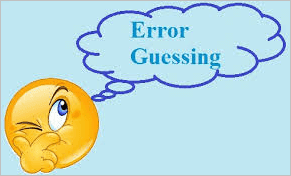
Error Guessing Testing (EGT) is a dynamic software testing technique employed to identify bugs by intuitively predicting potential error types and then designing test cases specifically to uncover them. Operating within the realm of black-box testing, EGT does not necessitate familiarity with the software’s internal structure.
In practical application, EGT is often combined with other testing methodologies like boundary value analysis and equivalence partitioning. It proves particularly beneficial in complex software systems where comprehensively anticipating all potential error conditions is challenging.
To execute EGT effectively, testers must possess a deep understanding of the software system under scrutiny, encompassing its functionality, requirements, and design. With this knowledge, testers intuitively speculate on conceivable error types, such as invalid input errors, out-of-bounds errors, divide-by-zero errors, null pointer exceptions, database errors, network errors, and concurrency errors.
Once a specific error type is identified, testers design relevant test cases to pinpoint the error. For instance, if testers suspect vulnerability to an invalid input error, they might create a test case that inputs an invalid value into a text field, aiming to provoke the error.
It is important to recognize that while EGT can be a potent method for bug detection, it does not offer a foolproof guarantee. Testers must possess in-depth familiarity with the software to accurately predict likely error scenarios. Additionally, EGT can be time-intensive, requiring the design and execution of numerous test cases.
EGT stands as a valuable tool in the software testing arsenal. Particularly advantageous in scrutinizing intricate software systems, it excels at discovering bugs that might evade detection through other testing techniques.
Why Error Guessing Testing?
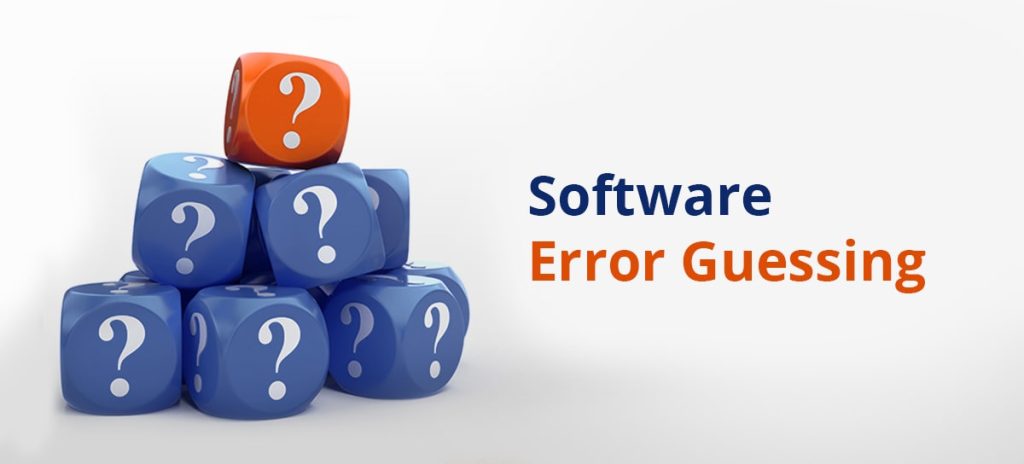
Error Guessing Testing is an informal software testing technique where testers use their intuition, experience, and creativity to predict and identify potential errors in a software application. Testers anticipate where faults might occur based on their understanding of the system, and then design specific test cases to uncover these errors. Unlike formal test cases, error guessing does not follow a predetermined script and allows testers to explore the software freely, simulating real-world usage scenarios. This approach helps in finding issues that might be missed by structured testing methods, adding a human element to the testing process. Error guessing is often used in conjunction with other testing techniques to provide a well-rounded assessment of the software’s quality and reliability.
- Informal Exploration: Error guessing allows testers to informally explore software, drawing on their intuition and experience to identify potential issues. This informal method often uncovers problems missed by formal test cases.
- User-Centric Perspective: Testers can anticipate errors from a user’s perspective, imagining how users might interact with the software. This perspective often reveals scenarios hard to predict through structured testing methods.
- Complementing Formal Testing: Error guessing acts as a complement to formal testing methods. It adds a human touch, utilizing testers’ creativity and experience to unveil unexpected issues and vulnerabilities.
- Handling Unconventional Scenarios: Error guessing effectively explores unconventional and unexpected scenarios, such as invalid inputs or boundary conditions. Testers design creative test cases to explore these unique paths.
- Early Issue Detection: Relying on testers’ intuition leads to early problem identification. Early detection is critical in preventing issues from escalating into significant challenges in later development stages.
- Adapting to Agile Environments: In agile or iterative development, where requirements change rapidly, error guessing offers a flexible testing approach. Testers can adapt quickly to new features or changes without extensive pre-planned test cases.
- Cost-Effectiveness: Error guessing proves cost-effective, especially in situations where extensive formal testing isn’t feasible due to time or budget constraints. Testers can focus on specific areas without the burden of extensive documentation.
- Utilizing Tester Expertise: Skilled testers possess domain knowledge and understand common pitfalls. Error guessing enables them to leverage this expertise, directing testing efforts toward areas more likely to have errors.
Error guessing testing is a valuable tool for software testing because it can help to find a wide variety of bugs, including complex and unexpected bugs. It is also a good way to learn about the software and to identify areas that need improvement.
Here are some specific reasons why error guessing testing is useful:
- It can be used to test any type of software, regardless of its complexity.
- It is not necessary to have a deep understanding of the software’s internal structure in order to use error guessing testing.
- It can be used to find bugs that are difficult to identify using other testing techniques, such as scripted testing.
- It can be used to learn about the software and to identify areas that need improvement.
- It can be used to supplement other testing techniques, such as boundary value analysis and equivalence partitioning.
Error Guessing Testing Example
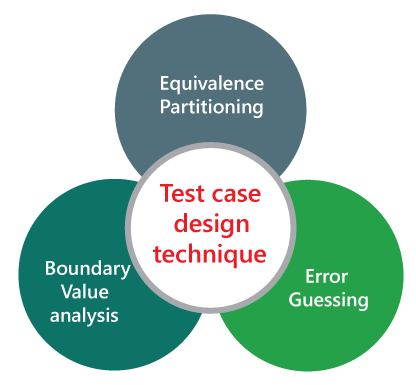
Example 1: Input Validation Errors Error guessing is instrumental in identifying input validation issues, including uncommon characters, lengthy inputs, or unexpected input combinations. Testers can observe how the system handles these inputs, assessing its ability to gracefully manage such scenarios and prevent unexpected behaviors or vulnerabilities.
Example 2: Error Handling and Recovery Testers can intentionally induce network outages, low memory situations, or unexpected system states to evaluate the system’s response. This includes examining how the system gracefully handles problems, recovers effectively, and provides appropriate error messages or logging information. These fault scenarios help assess the system’s resilience.
Example 3: Boundary Conditions and Constraints Error guessing is valuable for uncovering challenges related to boundary conditions and system constraints. Testers can explore scenarios that push the system to its limits, predicting hypothetical boundary values or combinations to uncover unexpected behaviors. This method detects system shortcomings and vulnerabilities in handling extreme situations.
Example 4: Unusual User Interactions Testers employ error guessing to replicate unexpected user behaviors not covered by typical test cases. This can involve unforeseen sequences of actions or combinations of features that might lead to errors. Investigating these atypical use patterns helps testers identify hidden faults or unexpected behaviors in the software.
Error guessing encourages testers to employ creative thinking and anticipate potential issues in various aspects of the software system. It prompts testers to adopt a user’s perspective and actively search for situations that might reveal problems. While error guessing enhances the testing process by adding human insight and creativity, it is important to note that it is not a substitute for formal testing. Instead, it supplements formal testing efforts, providing valuable perspectives for software quality assurance. Leveraging intuition and investigative skills is key to utilizing error guessing effectively, making it a valuable addition to the software testing toolkit.
Pros and Cons To Error Guessing Testing ?

Pros of Error Guessing Testing:
- Simplicity and Accessibility: Error guessing is straightforward, making it accessible even for testers with limited experience. Its simplicity allows a quick start in the testing process.
- No Need for Internal Structure Knowledge: Testers don’t require in-depth knowledge of the software’s internal structure. They can focus on the application’s behavior and user interactions.
- Versatility in Bug Identification: Error guessing is effective in finding a wide range of bugs, including complex and unexpected ones. It can uncover issues that might be challenging to detect through formal methods.
- Informative Learning Tool: Error guessing helps in understanding the software better. It highlights areas that need improvement, providing valuable insights for developers and stakeholders.
- Supplementary Testing Method: Error guessing serves as a valuable supplement to other testing techniques like scripted testing and boundary value analysis. It enhances the overall testing process by adding a creative and exploratory dimension.
Cons of Error Guessing Testing:
- Time-Consuming Test Case Creation: Designing and executing test cases for all potential error conditions can be time-intensive, especially in complex applications with numerous scenarios.
- Incomplete Error Coverage: It’s not always possible to anticipate all error conditions, leading to the possibility of missing certain bugs. Testers might overlook specific scenarios, resulting in incomplete coverage.
- Reproducibility Challenges: Reproducing bugs found through error guessing can be difficult. Lack of detailed steps or specific conditions might make it challenging to recreate the exact scenario.
- Dependency on Tester’s Knowledge: Effective use of error guessing requires a profound understanding of the software. Tester expertise and intuition play a crucial role in identifying potential error scenarios.
Effective Error Guessing Strategies:
- Focused Testing: Concentrate error guessing efforts on areas of the software most likely to contain bugs, ensuring a targeted approach for maximum impact.
- Diverse Techniques: Employ a variety of error guessing techniques, including black-box, white-box, and gray-box testing, to cover different aspects of the application.
- Thorough Documentation: Document findings in detail, enabling reproducibility and facilitating knowledge sharing among testers and developers.
- Integration with Other Techniques: Integrate error guessing testing with scripted testing and boundary value analysis to achieve comprehensive test coverage. Combining different methods ensures a more thorough examination of the software.
Error guessing testing, while valuable, requires careful planning and integration with other testing techniques to mitigate its limitations effectively. When used judiciously and in conjunction with diverse testing approaches, error guessing enhances software quality, uncovers critical issues, and contributes significantly to the testing process.
When to use the Error guessing technique in software testing?
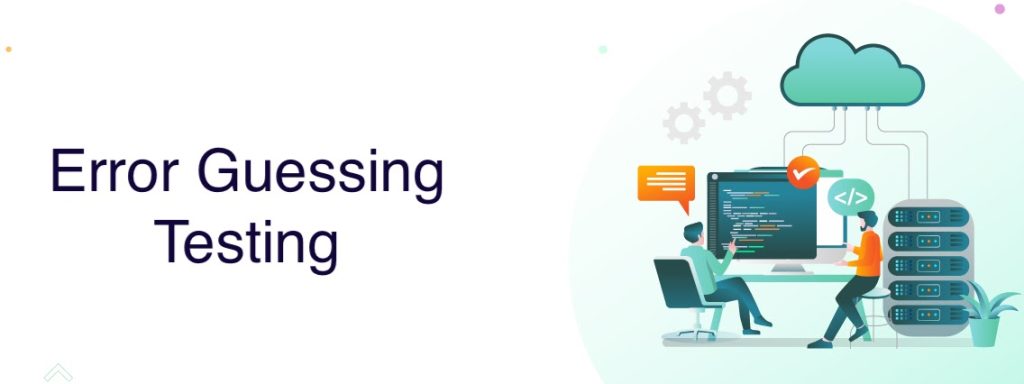
Error guessing, as a software testing technique, is best utilized in specific situations where its intuitive and exploratory nature can yield valuable results:
- Exploratory Testing Scenarios: Error guessing is an integral part of exploratory testing, allowing testers to actively explore the software, imagining various user interactions and potential problems. This technique is particularly effective in probing unexpected scenarios and behaviors during exploratory sessions.
- Ad-Hoc Testing: When there’s limited time for formal test case creation, ad-hoc testing with an error guessing approach can quickly unearth critical issues. Testers use their intuition and experience to focus on areas likely to have problems, providing rapid feedback.
- Usability Testing: Error guessing is invaluable for identifying user experience issues. Testers can simulate unconventional user behavior, predicting how users might interact with the software. This approach helps in exploring areas where user mistakes could occur and improves overall usability.
- Testing Complex Software Systems: In intricate and multifaceted applications, it’s challenging to predict all potential error scenarios. Error guessing is valuable for uncovering unforeseen issues in complex software where formal test cases might not cover every aspect.
- Early Development Phases: During the initial stages of development when formal requirements might not be fully defined, error guessing can initiate testing activities early. Testers can intuitively predict potential issues with new functionalities, providing valuable early insights.
- Rapid Agile Development: In agile or iterative development environments, where software evolves rapidly, error guessing can adapt quickly to changing features. Testers with domain knowledge can predict potential issues, ensuring rapid testing feedback for evolving functionalities.
- Supplementing Formal Testing: Error guessing complements formal testing methods like scripted testing and automated tests. It adds a creative and exploratory dimension, often discovering issues missed by structured approaches.
- High Domain Knowledge: Testers with deep domain understanding can effectively employ error guessing. Their extensive knowledge of the application and its users allows them to predict likely errors and behaviors accurately.
- Enhancing Test Coverage: Error guessing can be used to enhance test coverage by exploring areas not covered by formal test cases. It provides an additional layer of testing that focuses on user behavior and real-world usage scenarios, leading to a more comprehensive assessment.
It’s crucial to remember that error guessing should augment formal testing methods and should be applied judiciously in appropriate contexts to ensure the most effective and reliable results.
Thanks,






Leave a Reply
You must be logged in to post a comment.